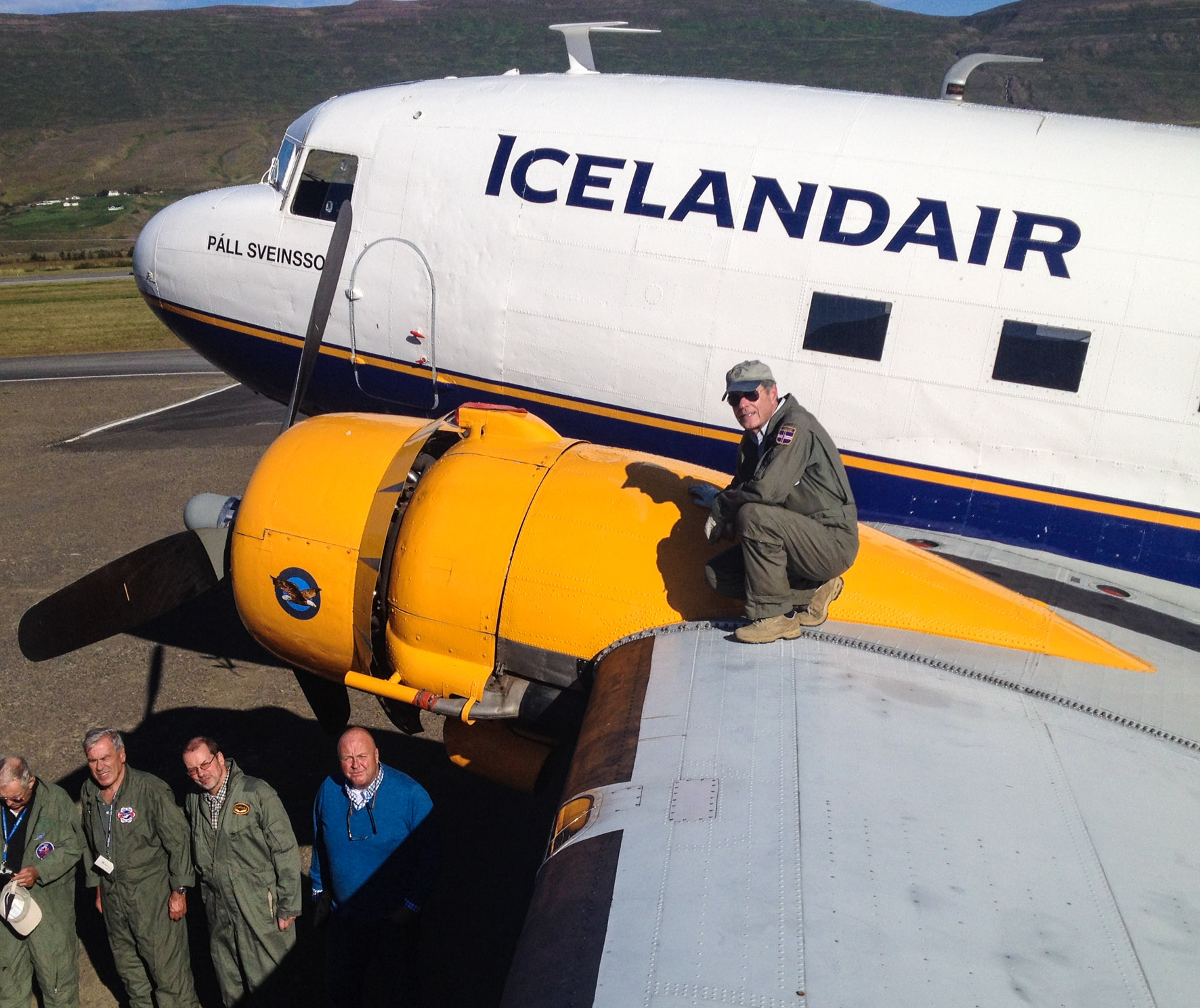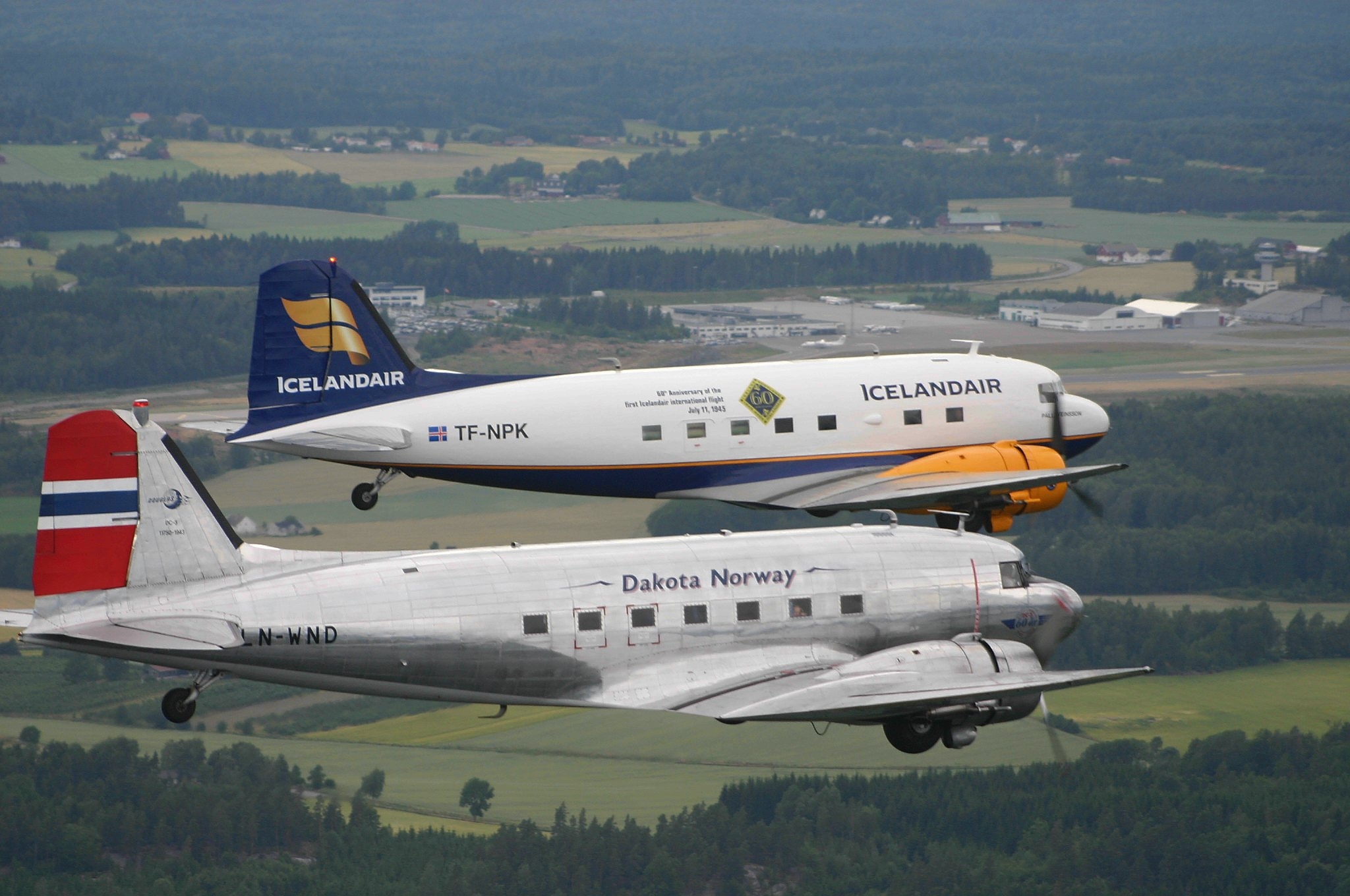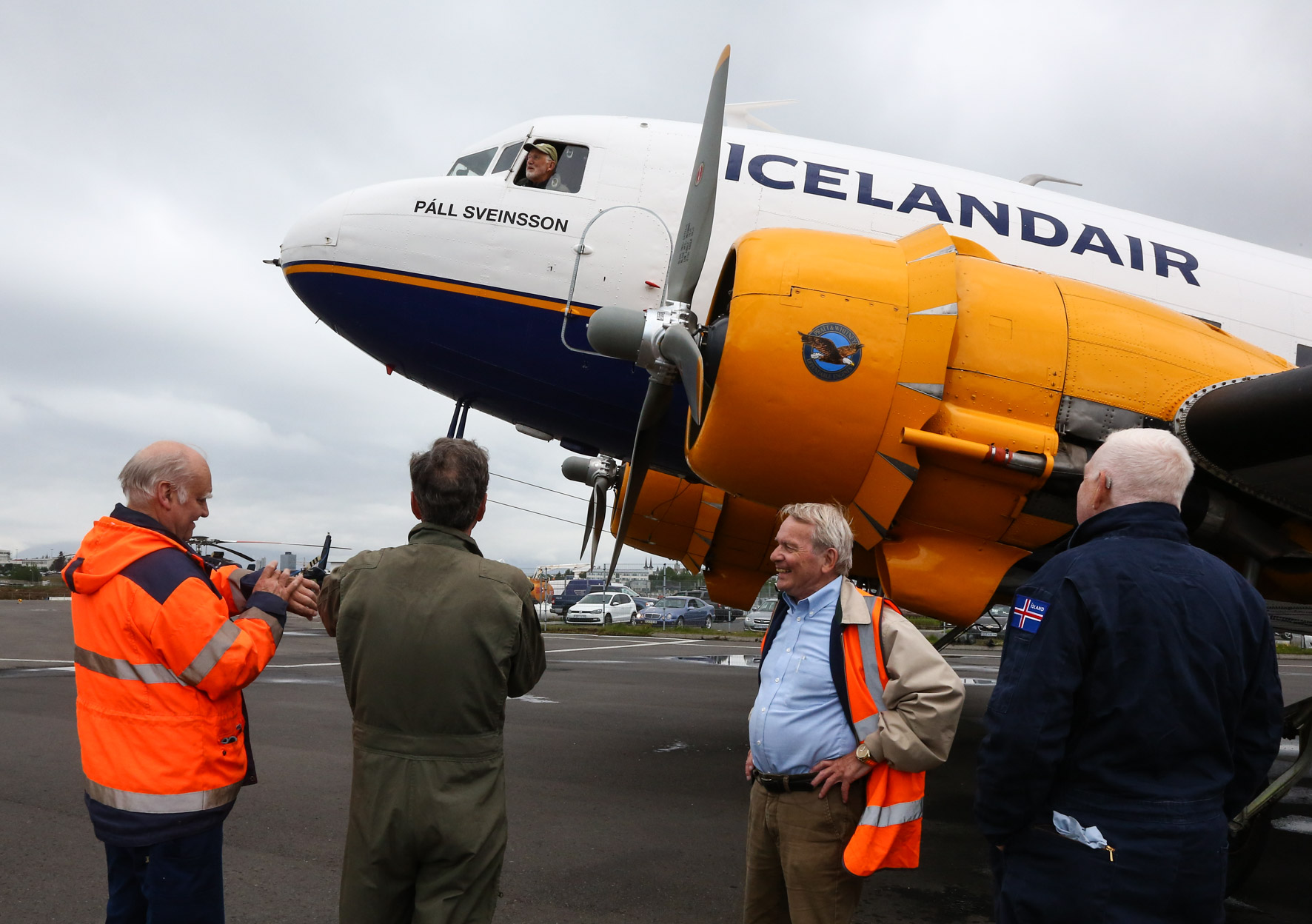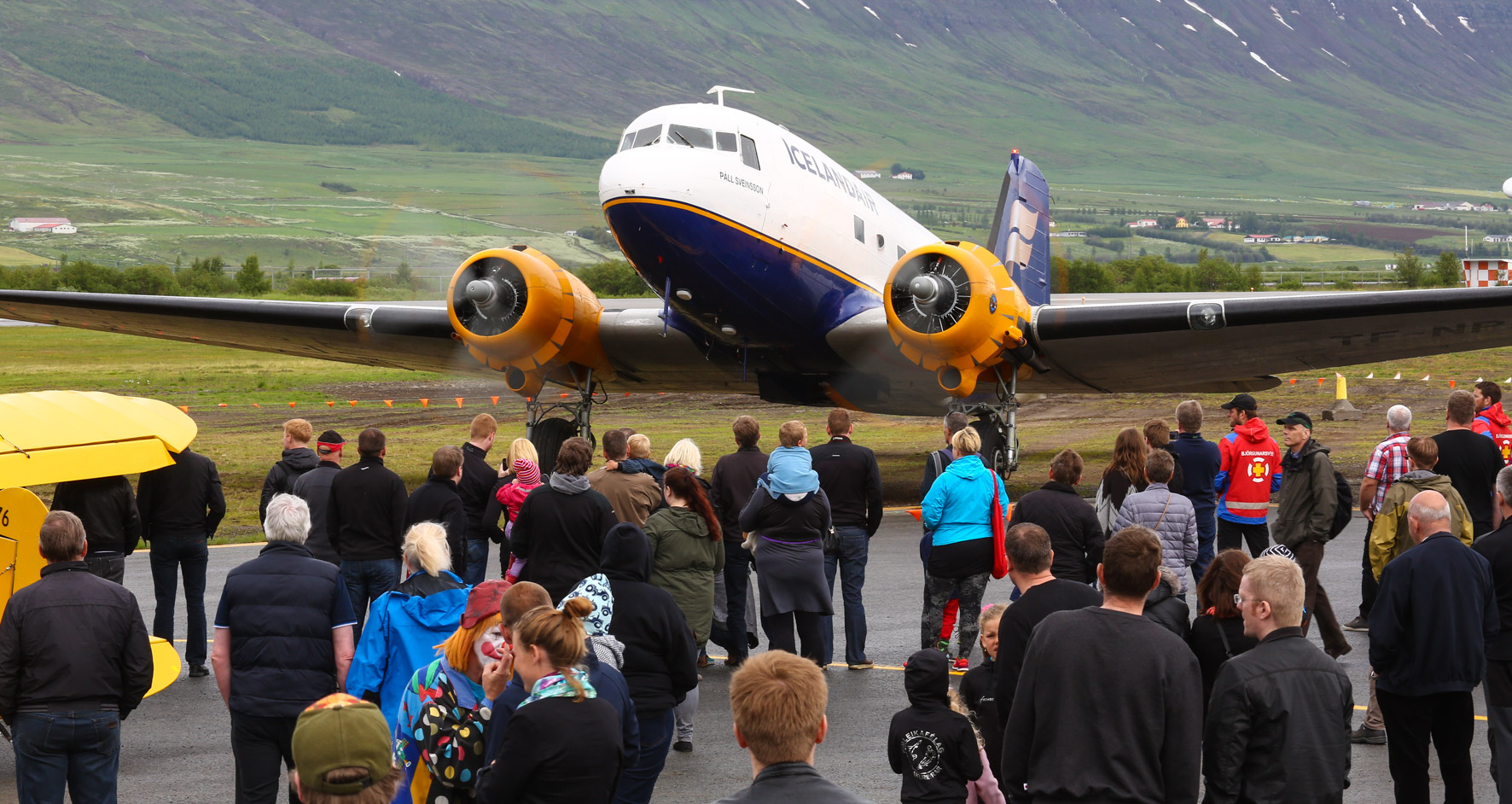The last flying Icelandic DC-3 could be ruined in days when a group of aviation enthusiasts rallied around the plane. They convinced the state owner to let them take care of it and later to make the veteran plane welcome guests at all aviation events in Iceland. Flugblogger learned how “DC3 Þristavinir” (Friends of DC-3) managed to stay on the wing, transfer the knowledge about the plane to a younger generation, and when Icelandic DC-3 will fly with passengers again.
The last from its tribe
Douglas planes have a remarkable image in Iceland. The first “Dakota” planes appeared on the island during World War II, later in peacetime became the main aircraft for developing aviation of the tiny country, which became truly independent in 1946. Back then DC-3 and DC-6B performed major flights, linking main towns of Iceland.
For the US army, Iceland continued to be an important place in the North Atlantic, thanks to the American airbase in Keflavik, which kept running after 1945. Transport planes performed refuel stops during supply flights across the Atlantic and served local duties.

DC-3 and DC-6B fit the requirements for both, civil and militaries, thanks to their ability to perform flight in a severe climate. “Accident of Geysir” is one of the stories, which illustrate this thesis the best. It is such remarkable, so deserves to be told.
It was a regular flight of the US Army DC-6B to Reykjavik when the plane encountered bad visibility and strong wind over Iceland. The conditions were so bad that the plane did not manage to reach its destination. The crew decided to perform an emergency landing on top of Vatnaökull, the biggest glacier in Europe. For four days the crew were fighting for their lives, meanwhile, rescue teams from Akureyri and Reykjavik were trying to reach the landing spot. When the weather allowed, the militaries sent a DC-3 on ski from Keflavik airbase to save the people. All onboard, but they could not take off again. At this moment the first rescue team arrived and took them all to Akureyri. The DC-3 was left abandoned on the glacier.
The winter came, and the plane was still there. Then Icelandic airline Loftleiðir requested the US army to sell the plane. The militaries had decided to shake off the frozen plane for about one dollar. The Icelanders came with a bulldozer to the place, where the plane was supposed to be, but saw nothing. They put up a tent, started to dig the snow, and found the plane. It was taken under the snow when a storm came, so the people had to hide inside the tent. After a couple of days, when the weather went down, it turned out that the plane had disappeared under the snow again. They had to dig it up again, then pull the bulldozer down from the glacier. On sand they performed a basic check of the DC-3 systems, to find out that there is still some charge in the batteries and fuel in the tanks. They tried to launch the engines and the plane came alive without any problems. So, they just took off and flew to Reykjavik. Loftleiðir used the plane a lot for local operations for several years, but later the plane left Iceland and ended up somewhere in the Philippines.
There were several DC-3s in Iceland, every one with its own story, but the common end – to be ruined in or beyond Iceland. Tómas Dagur Helgason, chairman and co-founder of “DC-3 Þristavinir” (“DC-3 friends” of Iceland club), told Flugblogger, that there were two planes, which became the reason for founding the club. “I was involved in flying the DC-3 with registration TF-NPK as an Icelandair pilot since 1996. At that time TF-NPK worked in Landgræðslan, the Icelandic state Department of Land Reclamation, who used the plane as a seeder. It came there from Air Iceland in 1973, when was replaced by Fokker F27, after 25 years of flying in civil aviation. Originally it came to Iceland the same year when was taken out of the Douglas factory in Long Beach, California, in October 1943 as C-47A for the US Army.
In 2003 Landgræðslan announced they would stop operations in a few years. I knew the plane personally and I knew the history of another DC-3 with tail TF-ISB, which was ruined days after was taken out on regular flights. So, I decided to try to save it. At that time, I was approached by a guy, involved in DC-3 operation in Copenhagen, so I visited them to learn more about their operations there. When I came home, I talked with my friends and we decided to form a club around it. We had a discussion with Landgræðslan and the final decision was made that we will take over the operations of the plane from 2005 and restore the plane. We started the club 3rd of March in 2005”.

Tómas Helgason does not remember when he saw the TF-NPK for the first time. Meanwhile, he spent his childhood near the aerodrome in Sauðarkrökkur in the north of Iceland, where he started to watch the plane from a very early age. It could be that TF-NPK was among them. He touched the yoke of this plane in 1986 and was piloting it until 2013, combining it with the training of other pilots on the DC-3.
“It is a totally different feeling of flying on TF-NPK. First, starting up the engines, which is so totally different from what we are doing today and so highly enjoyable. Then, it is a taildragger plane, which means ground handling of the plane is the most difficult part. Once you are airborne, you can call it sluggish, the plane answers late: you turn the yoke and then it is kind of thinking “Oh, shall I?”, then it comes. To maneuver it can be hard, especially if you are doing a lot of turns, but it feels very good to fly on it. If I may use the word, it forgives you many things. At the same time, it will punish you for a mistake, especially during crosswind landings and in the ground operation”, Tómas Helgason said.
After 2005 the DC-3 TF-NPK was kindly moved to its new base in Flugsafn Íslands (Aviation Museum of Iceland) in Akureyri.

Old problems and modern solutions
The club grows year after year. In 2018 there were more than 350 members on the list. However, among them, there are only nine pilots, who are skilled enough to fly on DC-3. Tómas Helgason was among them until 2013 when he lost his pilot license due to medical reasons. That year he was 52 years old and he was the youngest pilot of the club. The average age of other pilots is around 70. They all are former pilots from different Icelandic airlines. The majority from Icelandair, but also from Flugfélag Íslands (Air Iceland Connect), Loftleiðir, Íslandsflug, Air Atlanta Icelandic and others.
“When we need to fly the plane to somewhere in Iceland and I must find pilots, it is the question: who is available now. I start to call and see who is available, and, of course, who flew last time. Then, at first, I approached someone else, who was not flying. I try to spread out flight hours between pilots. Sometimes it ends with the same people because they are the only ones available. This is obviously a threat, we have been looking into it. We had plans to train pilots and mechanics on the plane a few years back, but this is a question about money to train pilots on the plane”, – Tómas Helgason said.

The most difficult part, Helgason told, is to maintain knowledge of the mechanics: how to fix the DC-3 and keep it up and running. Meanwhile, the core of the club is getting older, and the knowledge of the plane and its components is fading away. Younger people, Helgason said there are a lot of them, who want to join the club, but cannot learn all these features from the books only, they will have to do it with their hands and hours of practice on real aircraft.
It is not only a question of goodwill for younger pilots. To study piloting the 80-year-old plane they must get skills in real flights, which is devastating for the club’s budget. In 2018 the club managed to confirm certificates for five pilots, who are the only ones allowed to fly on DC-3 in Iceland now. Helgason’s biggest hope is lying down on the newest ground-based simulator of the DC-3 cockpit, which was built by MPS company in Amsterdam. It would allow the club to train more pilots with less money.
„The simulator was available for training this spring. I have gone there and tried the simulator myself. It is quite realistic. Our friends from other DC-3 clubs in Nordic countries started to use it and gave a good reply. We are planning to go with our pilots there next spring, early spring, and to brush up their skills on emergency procedures, which you cannot train in a real plane. We need as well to train younger pilots, same as mechanics, to move the skills from older ones to younger ones and keep the plane flying”, – Tómas Helgason said.
The budget for the DC-3
To confirm a certificate or obtain a new one a pilot must fly at least seven hours on DC-3. Ruff counting, one flying hour on this type in Iceland costs 250,000 ISK ($2000-2500). It includes not only petrol for the plane but also additional costs for engine reserve and all supplementation.
Meanwhile “Friends of DC-3” in Iceland is a non-profit organization. Tómas Helgason said the club is supported by different sources. First, membership is payware. Every participant contributes 3,000 ISK ($300) each year, which gives about 1 mln ISK (around $10 000) to the club. Second, when airshow organizers invite the plane, they compensate fuel costs for the flights there.
“Actually, Icelandair is our main sponsor, who gives most of the money. Without their support, the plane would not fly. They have supported us heavily over the years. Even when the plane was flying for the Landgræðslan, Icelandair took the plane to a hangar to do all major modifications, that were needed. Also, occasionally we have few other sponsors”, Tómas Helgason said.
According to a Flugblogg source, this year “DC-3 friends” in Iceland received 3 mln ISK from Icelandair. Then, according to Tómas Helgason, they had to pay 2,4 million IKR to the company in the Netherlands to recharge the fire extinguisher bottles on one engine that was accidentally shot during an inspection last winter.

The final budget for the club varies from year to year, he added. So far during their worst year, they had only 1 mln ISK, the best was with 5 mln ISK. However, the 5 mln ISK was given to the club because of the very special occasion. In 2005 Icelandair celebrated the 60th anniversary of its international flights and for this sent TF-NPK to get a new livery with company colours. That year the only Icelandic DC-3 flew a grand tour visiting the Flying Legends Airshow in Duxford, ceremonial events for Icelandair in Glasgow, and then to Nordic Dakota clubs in Copenhagen and Oslo. Since then TF-NPK has never flown beyond Iceland.
“We always fly the plane during springtime for proficiency check of pilots. We also try to make the plane visit possible both in Reykjavik and Akureyri. This year the plane came to “Wings’n’Wheels” in Mosfelsbær. I think in 2018 we will fly not more than 7 or 8 hours. But then the norm for a year, I would say, will be from 12 to 20 hours. Do not forget, the main reason for the “DC-3 friends” club to be founded is to restore the plane, to keep it flyable. Even though we fly only between 10 and 20 hours each year, the plane is in flyable condition. That is our main goal”, Tómas Helgason said.

The budget of the Icelandic DC-3 club looks like that of other Scandinavian Dakota clubs. However, for example, there is a significant difference from the Norway club, which is bigger and has additional support from the government. According to Norwegian legislation, vintage planes there are tax-free, the same law is active in Iceland but only for vintage automobiles. In addition, the Norwegian DC-3 has a freeware landing pass to all the state’s aerodromes. “This year we have approached the Icelandic authority to drop the charges for ICETRA, but they had refused”, Tómas Helgason said.
Another revenue source for the Norwegian club is the flight program, which they perform every year. Any member of the club can apply for the flight and feel the emotions of flying on DC-3. The membership is not free, and other Scandinavian clubs are bigger than Icelandic ones. According to Helgason, they have from 1500 to 3000 members each. Meanwhile, the idea of flights on DC-3 with passengers is alive in the Icelandic club too.

Future flights with feelings of the past
The only flying Icelandic DC-3 would take passengers on board again, to allow aviation fans to feel how it was about 50 years ago. The main problem is, that TF-NPK has only 2 seats in the cabin. Tómas Helgason wants to put more, but then troubles are incoming.
„We have the aim to be able to show other people the opportunity to have a unique experience of flying on DC-3. The main thing, which is holding us back is, we have to put passenger seats, which have to be tested and stand over a 9G test. We already got passenger seats from Boeing 757, and our plan is to put them three in a row: two on one side and one on the other side. These seats are even stronger than needed, but still, we must do the test. Even though DC-3 is not registered in the EASA environment, we must follow certain regulations. It is extremely expensive to send the seats out, to do the test there, so we want to perform it in Iceland”, Tómas Helgason said.
According to him, there is a long way from the idea to put the seats to the actual performance of the action. The first barrier was negotiations with Icelandic aviation authorities, and it was taken pretty fast. “They are with us”, said Helgason. The seats from Boeing 757 need to be modernized to fit into the DC-3 cabin, which means they have to be tested as a new experimental piece of construction. What kind of tests have to be done, and how to perform the tests – everything must go according to newly composed documents and procedures.
“There is a design organization, the department of Icelandair, that was making instructions for how to do the test. It has been worked on for many years, and ongoing for a too long time. Now the guys, who were working on this, left Icelandair. They founded their own Design Organization Approval (DOA). I am still in a good connection with them, they are going to finish this one”, Tómas Helgason said.

He explained the result of DOA work will be included in the TF-NPK documents package: chapter OMA (Operations Manuals Part A. General information and companies police) and OMD (Operations Manual Part D. Training Manual).
Establishing flights with passengers will allow the club to protect its future: “We are not planning to make any profit on operation on the plane. We are only planning to make operations on the plane self-sustaining. Everyone, who would be flying on the plane, will pay some part, which will cover this quarter of a million for one flying hour. So, we will have the money in the bank for new engine parts, propellers, and other stuff for the plane. We would do the same project as our friends in Nordic countries, to fly only with the club’s members. If someone wants to fly TF-NPK, this person should join us. We are not selling you seat, actually”.
According to open sources, the DC-3 in passenger version could fit up to 32 seats. Ruff counting, a one-hour flight for a TF-NPK passenger would cost around 8,000 ISK (about $80).
Icelandic TF-NPK and D-day
“June 2019 provides us with the very last opportunity to organize Daks over Normandy and to honor those who have paid so much to liberate Europe. For the first time since World War II will many of these magnificent aircraft be assembled in the very place where they saw their finest hour. From 2 to 9 June 2019 over thirty DC-3/C-47s will come together”, said the website Daksovernormandy.com. According to them, more than 250 paratroopers are going to recreate the landing in Normandy, jumping from Dakota planes.
Tómas Helgason is informed about the event: „They try to gather as many DC-3s as possible in Duxford or southern part of UK and then fly together across the English channel over Normandy, where many parachute jumpers will jump out from the planes. We are pushed to come there with our plane, we will aim for that, but it is a question of money”.











